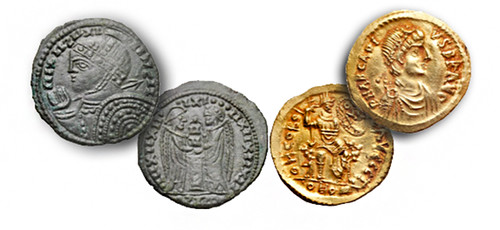
PREV ARTICLE
NEXT ARTICLE
FULL ISSUE
PREV FULL ISSUE
COINAGE OF THE BARBARIAN INVADERS
On September 8, 2014 Mike Markowitz published another great article in his Ancient Coin Series in CoinWeek. The subject this time was the coinage of the Barbarian invaders. Be sure to read the complete version online; here is a very short excerpt.
-Editor
In the fourth century, the Eurasian Steppe was a vast sea of grass extending for thousands of miles, from Mongolia in the East to the Danube in the West. Nomadic tribes roamed the steppe, fighting over grazing rights, women and honor. Occasionally a leader would emerge, unite the tribes, and lead them to pillage the farms and sack the cities of their more “civilized” neighbors, who called these nomads “barbarians”.
The Huns Coins give us a unique window into this chaotic era. Some were coins barbarian invaders minted themselves. Others were coins they looted or extorted from the Romans. In the case of the Huns, this might have included the rare solidi issued by Valentinian III in the name of his sister, Honoria.

The Goths As early as the third century, these tribes minted crude copies of Roman coins. Known today as “Uncertain Germanic” issues (see below), they are difficult to classify and have been little studied.

Toward the end of the fourth century, the Goths split into two branches: the Ostrogoths, who initially joined the Huns; and the Visigoths, who invaded Italy and sacked Rome in 410 but later became Roman allies. After Attila's empire broke up, the Ostrogoths became allies of Constantinople.
To read the complete article, see:
THE BOOK BAZARREWayne Homren, Editor The Numismatic Bibliomania Society is a non-profit organization promoting numismatic literature. See our web site at coinbooks.org. To submit items for publication in The E-Sylum, write to the Editor at this address: whomren@gmail.com To subscribe go to: https://my.binhost.com/lists/listinfo/esylum All Rights Reserved. NBS Home Page Contact the NBS webmaster 
|